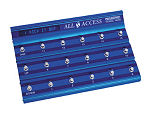Difference between revisions of "Midi control"
(link to new article) |
|||
| (11 intermediate revisions by the same user not shown) | |||
| Line 1: | Line 1: | ||
==''MIDI Controller''== | ==''MIDI Controller''== | ||
[[Image:Midi_fx1.jpg|left|Axess FX1 MIDI Foot Controller]] | [[Image:Midi_fx1.jpg|left|Axess FX1 MIDI Foot Controller]] | ||
| − | + | [[Image:Midi_fcb1010.jpg|left|Behringer FCB1010 MIDI Foot Controller]] | |
| + | [[Image:Midi_access.jpg|left|Rocktron All Access MIDI Foot Controller]] | ||
| + | There are basically two methods<sup>1</sup> of controlling the Axe-FX via MIDI. The simpler of the two methods is covered in the [[Midi_foot | MIDI Footswitch]] article and involves sending a patch change message to the MIDI device. Ex: Press Button 2 and the footswitch changes to Preset 002 on the device.<sup>2</sup> | ||
| + | The second method uses a controller type system. Traditionally it is more complex, more expensive and yet more powerful. This method sends CC messages to the Axe. Here is an instance where CC does not mean 'Cliff Chase' but rather Continuous Controller. Simply meaning the controller is sending a continuous message rather than a single message. This allows for constantly variable functions, such as a wah-wah pedal or volume control, to be utilized. | ||
| + | Furthermore rather than send a patch (preset) than contains a fixed chorus, reverb or echo effect built in this controller will allow you to turn these effects on/off at will. This allows a concept, if you will, to constantly be designing your sound 'on the fly'. Many controllers offer the best of both worlds whereas you are able to program several buttons for patch send and several buttons for CC operations. | ||
| + | This level of powerful control is related to the stompbox and pedalboard concept but allows this to take place in one powerful, flexible unit. | ||
| + | ---- | ||
| + | <small>1. Indicates two "common" methods realizing there exist more than a total of two methods.<br /> | ||
| + | 2. This excludes instances of MIDI mapping and/or preset offset.</small> | ||
| + | ---- | ||
| + | <!-- I pretty much end my contribution to this article at this point as I don't use the controller method. Perhaps someone that does can pick up here and finish out the article to be more informative. ~ thanks (mwd) --> | ||
| + | * [[MIDI_Bank_Select | MIDI Bank Select Article]] | ||
| + | * [[Axe_midi | Back to MIDI Main Menu]] | ||
| − | + | [[Category:Stubs]] | |
| + | [[Category:MIDI]] | ||
Latest revision as of 18:05, 29 March 2008
MIDI Controller
There are basically two methods1 of controlling the Axe-FX via MIDI. The simpler of the two methods is covered in the MIDI Footswitch article and involves sending a patch change message to the MIDI device. Ex: Press Button 2 and the footswitch changes to Preset 002 on the device.2
The second method uses a controller type system. Traditionally it is more complex, more expensive and yet more powerful. This method sends CC messages to the Axe. Here is an instance where CC does not mean 'Cliff Chase' but rather Continuous Controller. Simply meaning the controller is sending a continuous message rather than a single message. This allows for constantly variable functions, such as a wah-wah pedal or volume control, to be utilized.
Furthermore rather than send a patch (preset) than contains a fixed chorus, reverb or echo effect built in this controller will allow you to turn these effects on/off at will. This allows a concept, if you will, to constantly be designing your sound 'on the fly'. Many controllers offer the best of both worlds whereas you are able to program several buttons for patch send and several buttons for CC operations.
This level of powerful control is related to the stompbox and pedalboard concept but allows this to take place in one powerful, flexible unit.
1. Indicates two "common" methods realizing there exist more than a total of two methods.
2. This excludes instances of MIDI mapping and/or preset offset.


